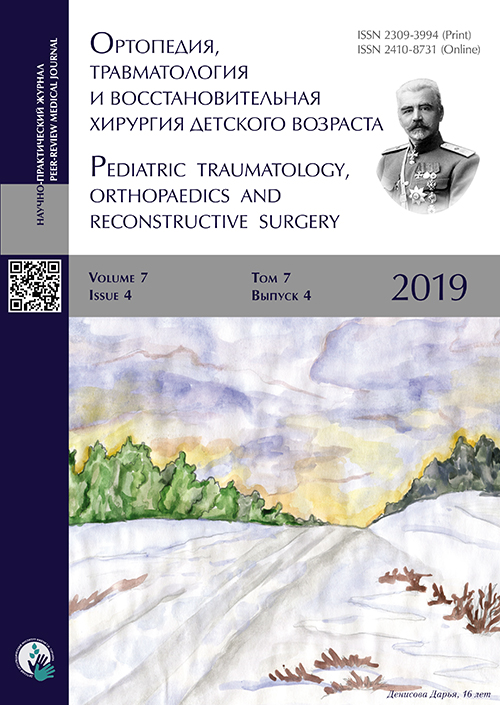Superior mesenteric artery syndrome following spinal deformity correction
- Authors: Strelnikova A.S.1, Kozyrev A.S.1, Vissarionov S.V.1, Kartavenko K.A.1, Murashko V.V.1
-
Affiliations:
- The Turner Scientific Research Institute for Children’s Orthopedics
- Issue: Vol 7, No 4 (2019)
- Pages: 105-112
- Section: Clinical cases
- URL: https://bakhtiniada.ru/turner/article/view/15738
- DOI: https://doi.org/10.17816/PTORS74105-112
- ID: 15738
Cite item
Abstract
Background. Superior mesenteric artery syndrome is a rare pathological condition caused by an abnormal transposition of the superior mesenteric artery from the abdominal part of the aorta. It results in compression of the distal part of the duodenum between the aorta and the superior mesenteric artery. It is clinically manifested by signs of acute intestinal obstruction, including pain in the epigastric region, nausea, and profuse vomiting. In the absence of timely treatment, patients may experience electrolyte disturbance, severe nutritional deficiency, the risk of perforation of the stomach, aspiration pneumonia, bezoar formation, thromboembolism, and the development of other life-threatening complications that can lead to death.
Case study. In the presented case study, superior mesenteric artery syndrome developed in a 17-year-old girl after surgical correction of a spinal deformity in the treatment of idiopathic scoliosis. This was due to postoperative loss of body weight, as well as a rapid change in the patient’s ratio of growth to body weight.
Discussion. Significant clinical improvement was achieved as a result of an integrated approach to the treatment of this complication. However, despite the successful result from conservative therapy, the patient remains at risk of developing chronic duodenal obstruction of varying severity, which may require surgical treatment.
Conclusion. With the untimely and incomplete treatment of superior mesenteric artery syndrome, the risk of developing chronic intestinal obstruction increases. Treatment of this complication begins with conservative therapy. In the absence of the effect of conservative therapy, and in the case of disease progression, the development of life-threatening conditions (such as bleeding and perforation) requires surgical treatment.
Full Text
##article.viewOnOriginalSite##About the authors
Angelina S. Strelnikova
The Turner Scientific Research Institute for Children’s Orthopedics
Author for correspondence.
Email: angelina.str.93@gmail.com
ORCID iD: 0000-0003-2013-1553
MD, Anesthesiologist-Intensivist, Department of Anesthesiology, Resuscitation and Intensive Care
Russian Federation, 64, Parkovaya str., Saint-Petersburg, Pushkin, 196603Aleksandr S. Kozyrev
The Turner Scientific Research Institute for Children’s Orthopedics
Email: alexkozirev@inbox.ru
ORCID iD: 0000-0002-2828-4063
MD, PhD, Chief Doctor, Anesthesiologist-Intensivist of the Department of Anesthesiology, Resuscitation and Intensive Care
Russian Federation, 64, Parkovaya str., Saint-Petersburg, Pushkin, 196603Sergei V. Vissarionov
The Turner Scientific Research Institute for Children’s Orthopedics
Email: vissarionovs@gmail.com
ORCID iD: 0000-0003-4235-5048
MD, PhD, D.Sc., Professor, Correspondent Member of RAS, Deputy Director for Research and Academic Affairs, Head of the Department of Spinal Pathology and Neurosurgery
Russian Federation, 64, Parkovaya str., Saint-Petersburg, Pushkin, 196603Kirill A. Kartavenko
The Turner Scientific Research Institute for Children’s Orthopedics
Email: med-kart@yandex.ru
ORCID iD: 0000-0002-6112-3309
MD, PhD, Orthopedic and Trauma Surgeon of the Department of Spinal Pathology and Neurosurgery
Russian Federation, 64, Parkovaya str., Saint-Petersburg, Pushkin, 196603Vladislav V. Murashko
The Turner Scientific Research Institute for Children’s Orthopedics
Email: v.murashko@gmail.com
ORCID iD: 0000-0002-2201-6906
MD, Orthopedic and Trauma Surgeon of the Department of Spinal Pathology and Neurosurgery
Russian Federation, 64, Parkovaya str., Saint-Petersburg, Pushkin, 196603References
- Farina R, Foti PV, Cocuzza G, et al. Wilkie’s syndrome. J Ultrasound. 2017;20(4):339-342. https://doi.org/10.1007/s40477-017-0257-2.
- Welsch T, Büchler MW, Kienle P. Recalling superior mesenteric artery syndrome. Dig Surg. 2007;24(3):149-156. https://doi.org/10.1159/000102097.
- Ylinen P, Kinnunen J, Höckerstedt K. Superior mesenteric artery syndrome. A follow-up study of 16 operated patients. J Clin Gastroenterol. 1989;11(4):386-391.
- Mathenge N, Osiro S, Rodriguez II, et al. Superior mesenteric artery syndrome and its associated gastrointestinal implications. Clin Anat. 2014;27(8):1244-1252. https://doi.org/10.1002/ca.22249.
- Schwartz A. Scoliosis, superior mesenteric artery syndrome, and adolescents. Orthop Nurs. 2007;26(1):19-24. https://doi.org/10.1097/00006416-200701000-00007.
- Kumar R, Jaiswal G, Bhargava A, Kundu J. Superior mesenteric artery syndrome: Diagnosis and management. Kathmandu Univ Med J (KUMJ). 2016;14(55):288-291.
- Barquín-Yagüez J, Abadía Barno P, García Pérez JC. Superior mesenteric artery syndrome: an uncommon cause of intestinal obstruction. Rev Esp Enferm Dig. 2017;109(1):60.
- Oguz A, Uslukaya O, Ülger BV, et al. Superior mesenteric artery (Wilkie’s) syndrome: A rare cause of upper gastrointestinal system obstruction. Acta Chir Belg. 2016;116(2):81-88. https://doi.org/10.1080/00015458. 2016.1139830.
- Eisenson DL, Shah KN, Cohen EM, Eberson CP. Unusual mechanism for superior mesenteric artery syndrome after scoliosis surgery. R I Med J. 2017;100(8):32-35.
- Todd SR, Marshall GT, Tyroch AH. Acute gastric dilatation revisited. Am Surg. 2000;66(8):709-710.
- Дьяконова Е.Ю., Бекин А.С., Поддубный И.В., и др. Острое расширение желудка у детей // Педиатрическая фармакология. – 2014. – Т. 11. – № 3. – С. 99–102. [Dyakonova EY, Bekin AS, Poddubniy IV, et al. Acute gastric dilatation in children. Pediatric pharmacology. 2014;11(3):99-102. (In Russ.)]
- Watanabe S, Terazawa K, Asari M, et al. An autopsy case of sudden death due to acute gastric dilatation without rupture. Forensic Sci Int. 2008;180(2-3):e6-e10. https://doi.org/10.1016/j.forsciint.2008.07.005.
- Виссарионов С.В., Кокушин Д.Н., Дроздецкий А.П., Белянчиков С.М. Технология использования 3D-KT-навигации в хирургическом лечении детей с идиопатическим сколиозом. – Хирургия позвоночника. – 2012. – № 1. – С. 41–47. [Vissarionov SV, Kokushin DN, Drozdetsky AP, Belyanchikov SM. The 3D-CT navigation technology for surgical treatment of children with idiopathic scoliosis. Spine surgery. 2012;1:41-47. (In Russ.)]. https://doi.org/10.14531/ss2012.1.41-47.
- Osegueda de Rodríguez EJ, Hernández-Villegas AC, Serralde-Zúñiga AE, Reyes-Ramírez ALDC. The two sides of superior mesenteric artery syndrome treatment: conservative or surgical management? Nutr Hosp. 2017;34(4):997-1000. https://doi.org/10.20960/nh.1006.
- Рыжакова Ю.П., Баиндурашвили А.Г. Синдром спинального вытяжения после оперативной коррекции тяжелого сколиоза // XI Российский национальный конгресс «Человек и его здоровье»; Санкт-Петербург, 21–25 ноября 2006 г. – СПб., 2006. – С. 91. [Ryzhakova YP, Baindurashvili AG. Sindrom spinal’nogo vytyazheniya posle operativnoy korrektsii tyazhelogo skolioza. In: Proceedings of the 11th Russian National Congress “Chelovek i ego zdorov’e”; Saint Petersburg; 21-25 Nov 2006. Saint Petersburg; 2006. (In Russ.)]
Supplementary files














